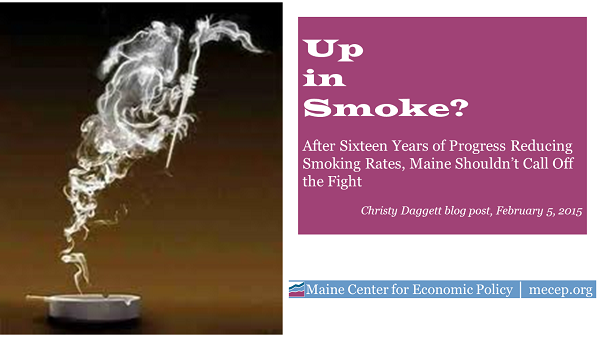Maine policymakers mostly have resisted caving into the temptation to spend tobacco settlement funds on other purposes – until now. The governor’s proposed budget would cut $10 million from tobacco settlement-funded work done by the Maine Center for Disease Control and the Healthy Maine Partnerships. This proposal isn’t good for Maine’s people (especially young people) – or for reining in Mainers’ health costs.
The four major tobacco companies and the attorneys general of 46 states reached a master settlement agreement in 1998, acknowledging that the companies sold addictive products that caused an epidemic of lung cancer and cardiovascular disease, the corporations agreed to pay $206 billion to the states over 25 years. The tobacco settlement is more than halfway over – states received the first payment in 1999. But many states have little to show for the billions of dollars. Instead of directing tobacco settlement monies toward keeping kids from smoking and helping smokers quit, some states redirected the funds to other purposes – just as the governor’s budget proposes.
Tobacco prevention efforts work.
In 1996, Maine had the highest smoking rate among young adults in the nation. Legislators responded by targeting tobacco settlement funds to a statewide tobacco program and establishing the Healthy Maine Partnerships – community health organizations scattered across the state. Cigarette smoking rates among Maine teens plummeted 67 percent over the next sixteen years.In contrast, smoking rates in states like Kentucky and West Virginia – where legislators spent the settlement funds on things like agricultural centers and economic development incentives – are now the highest in the nation.
Illness tied to tobacco use is expensive to treat – and costs thousands of lives each year.
It took 40 years to halve adult smoking rates in the U.S. While that’s a public health success story, a history of past heavy smoking leaves a long trail of sickness and mortality. It’s estimated that 2,400 Mainers die due to smoking each year, and health costs linked to tobacco-related diseases total $811 million annually.
Tobacco companies haven’t given up – and neither should we.
Even at current spending levels, tobacco companies outspend Maine’s tobacco prevention efforts by 5 to 1. Over $40 million in tobacco marketing floods the state annually. New innovations, such as flavored cigars and e-cigarettes, are harder to regulate and are marketed in locations frequented by teenagers.
Public health and primary care are complementary – not a zero-sum game.
The proposed budget takes the tobacco settlement monies from prevention and reallocates them to higher primary care reimbursement and cost-saving initiatives in the Medicaid program. But this doesn’t have to be an either/or proposition. There’s no shortfall in the Department of Health and Human Services budget. If the governor’s proposed budget didn’t also constrict revenue to fund income tax cuts that mainly benefit the wealthy, public health and primary care would not be set against each other. They’re not competing priorities.
In the same week the budget proposal was released, the Journal of American Medicine featured a retrospective on the precursor to the Healthy Maine Partnerships – the Franklin County Cardiovascular Health Program. Maine doctor Burgess Record, M.D., set out to go into his community, talk with people, and help them with strategies to prevent heart disease: quit smoking; take walks. And it worked. Smoking quit rates improved, patients’ cholesterol went down, and hospitalizations declined. There’s no budget emergency forcing these cuts to anti-tobacco efforts. State budgets reflect our priorities, and cuts like those proposed to public health and anti-tobacco work are penny wise, pound foolish, and the wrong priorities for Maine.



